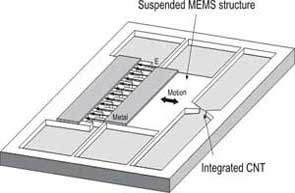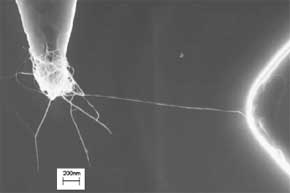| Posted: Mar 17, 2006 | |
A new process allows growing carbon nanotubes directly onto MEMS |
|
| (Nanowerk News) Researchers in Switzerland have successfully integrated carbon nanotubes (CNTs) directly into a polysilicon chip. This technique is opening the way towards NEMS and CNT based system integration and the synthesis and evaluation of mechanical nano-scale transducers based on CNTs. | |
  | |
| (Left) Schematic of a MEMS with an integrated CNT (Source: ETH Zurich). (Right) Scanning electron microscopy image of an individual nanotube grown to span the gap between a polysilicon actuator and an anchor. (Reprinted with permission from Elsevier) | |
| The group reports their findings titled "Process integration of carbon nanotubes into microelectro- mechanical systems" (article in press) in the Jan.20, 2006 online edition of Sensors and Actuators A: Physical. In this paper they describe the process flow and characterization of their novel approach to integrate nanotube growth into batch fabricated MEMS. | |
| Alain Jungen, researcher and author of the study and Christofer Hierold, professor of Micro- and Nanosystems at the ETH Zurich, explain to Nanowerk: | |
| "In our paper we demonstrate a new process allowing direct synthesis of carbon nanotubes onto MEMS. The MEMS chips were successfully post-processed with electron beam lithography combined with lift-off of catalyst layers." | |
| "With our novel process, individual or multiple tubes can be directly grown between movable posts and electrically connected. This way direct and reliable measurement techniques can be developed and used to accelerate research and evaluation of nanotube transducer properties." | |
| CNTs are arguably the most studied nanomaterials in recent years due to their fascinating physical properties. Apart from their hardness and toughness they have demonstrated exceptionally high thermal conductivity, eventually exhibiting a property known as "ballistic conduction." This makes them ideal candidates for highly integrated electromechanical nanosystems (NEMS). | |
| In developing NEMS major challenges still need to be overcome, foremost controlled and reproducilble integration of the tubes by local growth or self-assembly and the fundamental characterization of electromechanical effects in carbon nanotubes. Only then can CNT-based NEMS become a reality. | |
| A research project in Hierold's group, called "Integrated nano transducers: fundamental characterization of electromechanical effects in carbon nanotubes" is focussing on exactly this problem area. | |
 By
Michael
Berger
– Michael is author of three books by the Royal Society of Chemistry:
Nano-Society: Pushing the Boundaries of Technology,
Nanotechnology: The Future is Tiny, and
Nanoengineering: The Skills and Tools Making Technology Invisible
Copyright ©
Nanowerk LLC
By
Michael
Berger
– Michael is author of three books by the Royal Society of Chemistry:
Nano-Society: Pushing the Boundaries of Technology,
Nanotechnology: The Future is Tiny, and
Nanoengineering: The Skills and Tools Making Technology Invisible
Copyright ©
Nanowerk LLC
|
|
Become a Spotlight guest author! Join our large and growing group of guest contributors. Have you just published a scientific paper or have other exciting developments to share with the nanotechnology community? Here is how to publish on nanowerk.com.
